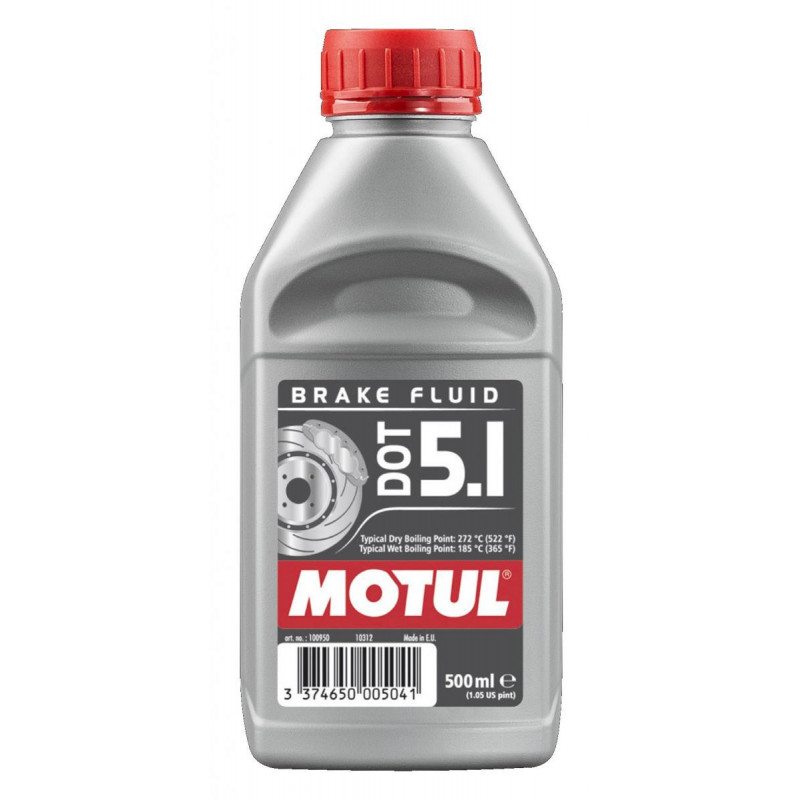- −25%

Välj din fordonsmodell


TYPE OF USE
For all types of hydraulically actuated brake and clutch systems requiring fluids meeting DOT 3, DOT 4, or DOT 5.1 specifications as per manufacturers’ recommendations. Fluidity specially designed for anti-locking brake systems (ABS) and other electronic stability programs (ESP, ASR,...).
| PERFORMANCES |
| STANDARDS Long life fluid: FMVSS 116 DOT 3 / 116 DOT 4 / 116 DOT 5.1 NON SILICONE BASE ISO 4925 (5.1, 4 & 3) SAE J1703
MOTUL DOT 5.1 high wet boiling point (185°C / 365°F) is superior than the requirements of the standards DOT 3 (140°C mini / 284°F mini), DOT 4 (155°C mini / 311°F mini) and DOT 5.1 (180°C mini / 356°F mini), and therefore enables longer use of this product. Indeed, DOT 3, DOT 4 or DOT 5.1 brake fluids have the property of absorbing moisture from the air, which reduces their boiling points and therefore braking safety. The wet boiling point is measured after moistening the product with 3% water in order to be representative of the state of the fluid after 1 year of use. Perfectly neutral with seals used in braking systems. Anti-corrosion. Specially designed for anti-locking brake systems (ABS): The viscosity at cold temperature (820 mm²/s at -40°C / -40°F) of MOTUL DOT 5.1 is lower than DOT 4 (up to 1800 mm²/s) and DOT 3 (up to 1500 mm²/s) brake fluid specifications and allows easier fluid circulation and flow through the micro-valves of anti-locking systems for better response of ABS and other electronic stability programs (ESP, ASR,...) requiring quick brake systems actuation. |
| RECOMMENDATIONS |
|
Oil changes: 12 to 24 months according to the manufacturers' recommendations. For safety advice, draining once a year is recommended. Mixable with DOT 3, DOT 4 and DOT 5.1 NON SILICONE BASE products. Do not mix with silicone (DOT 5 silicone base) or mineral base fluids (LHM). Store brake fluid in its original container, tightly closed to avoid absorption of moisture. Aggressive chemical product if contact with hands, paint or varnish. If skin contact, rinse thoroughly with water. |
| PROPERTIES | |
| Color Visual | Yellow |
| Viscosity at 100°C (212°F) | 2.1 mm²/s |
| Viscosity at -40°C (-40°F) | 820.0 mm²/s |
| Dry boiling point |
272.0 °C / 522.0 °F |
| Wet boiling point |
185.0 °C / 365.0 °F |
| Modell | År | |
|---|---|---|
| RS 660 | 2021 |
Välj
|
| RS 660 | 2022 |
Välj
|
| RS 660 | 2023 |
Välj
|
| RS 660 | 2024 |
Välj
|
| RS 660 | 2025 |
Välj
|
| RSV4 1100 E5 | 2021 |
Välj
|
| RSV4 1100 E5 | 2022 |
Välj
|
| RSV4 1100 E5 | 2023 |
Välj
|
| RSV4 1100 E5 | 2024 |
Välj
|
| RSV4 1100 E5 | 2025 |
Välj
|
| RSV4 1100 Factory E5 | 2021 |
Välj
|
| RSV4 1100 Factory E5 | 2022 |
Välj
|
| RSV4 1100 Factory E5 | 2023 |
Välj
|
| RSV4 1100 Factory E5 | 2024 |
Välj
|
| RSV4 1100 Factory E5 | 2025 |
Välj
|
| Tuareg 660 | 2021 |
Välj
|
| Tuareg 660 | 2022 |
Välj
|
| Tuareg 660 | 2023 |
Välj
|
| Tuareg 660 | 2024 |
Välj
|
| Tuareg 660 | 2025 |
Välj
|
| Tuono 660 | 2021 |
Välj
|
| Tuono 660 | 2022 |
Välj
|
| Tuono 660 | 2024 |
Välj
|
| Tuono 660 | 2025 |
Välj
|
| Tuono V4 1100 | 2021 |
Välj
|
| Tuono V4 1100 | 2022 |
Välj
|
| Tuono V4 1100 | 2023 |
Välj
|
| Tuono V4 1100 | 2024 |
Välj
|
| Tuono V4 1100 | 2025 |
Välj
|
| Tuono V4 1100 Factory | 2015 |
Välj
|
| Tuono V4 1100 Factory | 2016 |
Välj
|
| Tuono V4 1100 Factory | 2017 |
Välj
|
| Tuono V4 1100 Factory | 2018 |
Välj
|
| Tuono V4 1100 Factory | 2019 |
Välj
|
| Tuono V4 1100 Factory | 2020 |
Välj
|
| Tuono V4 1100 Factory | 2021 |
Välj
|
| Tuono V4 1100 Factory | 2022 |
Välj
|
| Tuono V4 1100 Factory | 2023 |
Välj
|
| Tuono V4 1100 Factory | 2024 |
Välj
|
| Tuono V4 1100 Factory | 2025 |
Välj
|
| Tuono V4R | 2011 |
Välj
|
| Tuono V4R | 2012 |
Välj
|
| Tuono V4R | 2013 |
Välj
|
| Tuono V4R | 2014 |
Välj
|
Din uppskattning av recensionen kan inte skickas
Anmäl kommentar
Rapporten har skickats
Din rapport kunde inte skickas
Skriv din recension
Recension skickad
Din recension kunde inte skickas

TYPE OF USE
For all types of hydraulically actuated brake and clutch systems requiring fluids meeting DOT 3, DOT 4, or DOT 5.1 specifications as per manufacturers’ recommendations. Fluidity specially designed for anti-locking brake systems (ABS) and other electronic stability programs (ESP, ASR,...).

